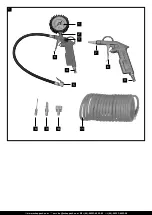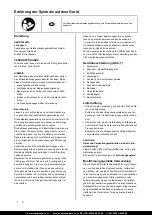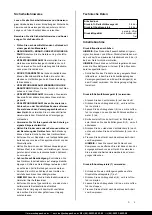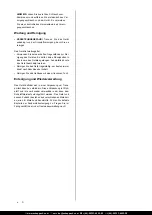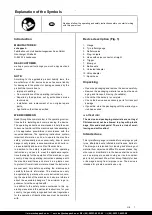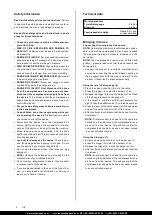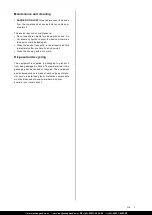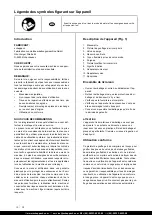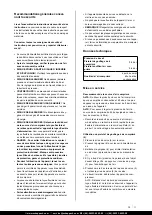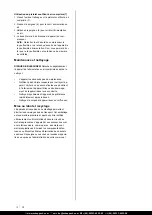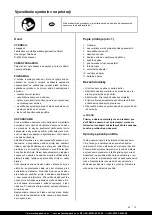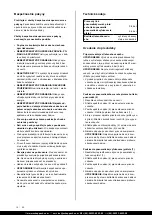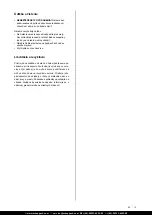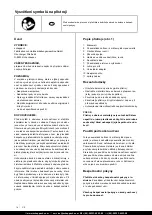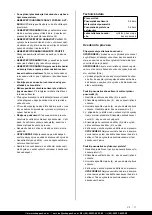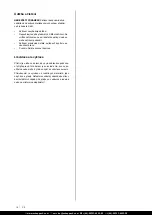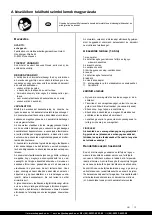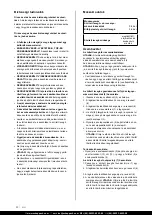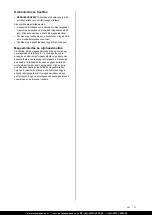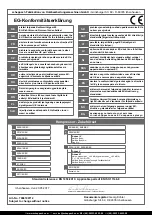
8
GB
www.scheppach.com
+(49)-08223-4002-99
+(49)-08223-4002-58
Technical data
Working pressure
Tyre inflator gauge
Blow gun
0-8 bar
0-6 bar
Compressed air quality
Cleaned, oil- and
condensate-free
Bringing into use
Connecting the compressed air source
NOTE:
Operate the product only with cleaned, conden
-
sate and oilfree compressed air and never exceed
the maximum working air pressure at the device of 8
bar (6 bar).
NOTE:
The compressed air source must be fitted with
a (filter) / pressure reducer so that the air pressure can
be regulated.
•
Connect the product to a suitable compressed air
source by connecting the quickrelease coupling of
the air supply hose with the plugin nipple (4) to the
product. It locks itself in place automatically.
Using the tyre inflator gauge (2)
1.
Place the valve connector (5) on to the valve.
2.
Press the trigger (6) to start the delivery of air.
3.
Release the trigger 6 to stop the delivery of air. Read
off the filling pressure on the gauge (1) .
4.
If the object is overfilled with air (air pressure too
high): Press the deflator valve (3) to release some air.
5.
Press the lever of the valve connector (5) downwards
and pull the valve connector (5) off the valve.
6.
After you finish work, disconnect the device from the
compressor.
NOTE:
First disconnect the hose from the compres
-
sor and only then disconnect the compressed air sup
-
ply hose from the device. This will ensure that the
compressed air supply hose does not wave around
in an uncontrolled manner.
Using the blow gun (7)
1.
Screw an extension nozzle on to the blow gun (7).
2.
Press the trigger (6) to start the delivery of air.
3.
Release the trigger (6) to stop the delivery of air.
4.
After you finish work, disconnect the device from the
compressor.
NOTE:
First disconnect the hose from the compres
-
sor and only then disconnect the compressed air sup
-
ply hose from the device. This will ensure that the
compressed air supply hose does not wave around
in an uncontrolled manner.
Safety information
Read all the safety advice and instructions.
Failure
to observe the safety advice and instructions could re
-
sult in serious injury and / or damage to property.
Keep all the safety advice and instructions in a safe
place for future reference!
•
Check the air pressure with a suitable manom-
eter after filling.
•
RISK OF FIRE, EXPLOSION AND DAMAGE TO
HEALTH!
The device must be used in wellventilat
-
ed areas only.
•
DANGER OF INJURY!
Never exceed the maximum
allowable working air pressure of 8 bar. Use a pres
-
sure reducer to set the working air pressure.
•
RISK OF RECOIL FORCES!
High working pressures
can give rise to recoil forces that under certain condi-
tions can result in danger from continuous loading.
•
DANGER OF INJURY! IMPROPER USE!
Never point
the device at people or animals.
•
DANGER OF INJURY!
Never use oxygen or other
combustible gas as the energy source.
•
DANGER OF INJURY! First disconnect the hose
from the compressed air source and only then
disconnect the compressed air supply hose from
the device.
This will ensure that the compressed air
supply hose does not wave around or recoil in an un
-
controlled manner.
•
For your own safety, wear suitable personal pro-
tective equipment.
•
Keep children and other people away while you
are operating the device.
Distractions can cause
you to lose control of the device.
•
Disconnect the device from the compressed air
source before carrying out any repairs or mainte
-
nance of the device or moving it to another location.
•
When removing the hose coupling, hold the hose
tightly in your hand to avoid injury caused by the hose
shooting backwards.
•
Look out for damage on the device.
Check the de-
vice for damage before bringing it into use. Do not
use the device if you discover any defects.
•
Do not kink the device’s hose, otherwise you may
damage it.
•
NOTE!
Observe the safety advice provided by the
manufacturer of your inflatable article.
•
Do not remove rating plates or labels they are safe
-
tyrelevant parts of the device.
•
If you are inexperienced in the use of this type of de
-
vice, you should seek out information or training to
learn how to handle it safely.


